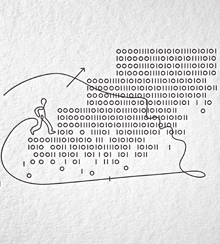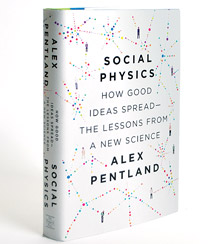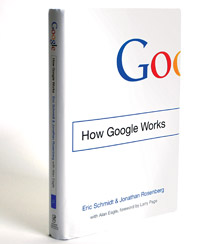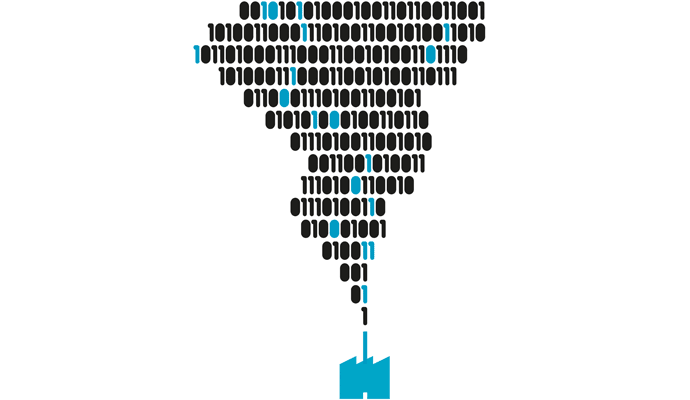Best Business Books 2014: Innovation
Greasing the Skids of Invention
Erik Brynjolfsson and Andrew McAfee
The Second Machine Age: Work, Progress, and Prosperity in a Time of Brilliant Technologies
(W.W. Norton, 2014)
Alex Pentland
Social Physics: How Good Ideas Spread—The Lessons from a New Science
(Penguin Press, 2014)
Eric Schmidt and Jonathan Rosenberg, with Alan Eagle
How Google Works
(Business Plus, 2014)
These days, it seems as though every business challenge has the same solution: innovation. Innovation is the watchword for generating fast growth in the very slow recovery from the Great Recession, and, thanks largely to Clayton Christensen’s concept of disruptive innovation, it’s the narrative center of gravity in Silicon Valley and the rest of the global tech community. But if innovation is the answer, the obvious next question is how to innovate.
This year’s three best business books on innovation offer answers to this crucial query in intriguing and insightful, if sometimes indirect, ways. In The Second Machine Age, economist Erik Brynjolfsson and information technologist Andrew McAfee suggest that smart machines are not only the products of innovation, but also essential enablers of innovation prowess. In Social Physics, MIT data scientist Alex Pentland offers a data-driven and eye-opening inquiry into the flow of ideas among people. And in How Google Works, high-level company insiders Eric Schmidt and Jonathan Rosenberg, with Alan Eagle, take us down to where the rubber meets the road.
Innovation Cyborgs
In The Second Machine Age: Work, Progress, and Prosperity in a Time of Brilliant Technologies, Erik Brynjolfsson and Andrew McAfee of the MIT Center for Digital Business contend that we have entered an era during which machines will extend our mental powers in the same way that they’ve already extended our physical might. The authors point to Google’s driverless cars and Apple’s Siri as the early examples of what will soon be a flood of smart machines. The authors don’t map the exact channels that this flood will follow, but by showing how digital capabilities have become ever more sophisticated (and will continue to gain in sophistication in the future), they make a compelling case that smart machines will shift and blur the line between the human and digital domains. Routine tasks both manual and cognitive that were heretofore reserved for humans will increasingly become digitized.
Brynjolfsson and McAfee are convinced that the overall effect of smart digital technologies will be profoundly beneficial. They predict that the growth of these technologies will yield an exponential increase in the trajectory of human social development for the foreseeable future. As digital technologies are combined and recombined, abundance will replace scarcity as the norm in economics, bringing greater choice and freedom. For instance, digital technology should help us live more lightly on the planet than the machine technologies that preceded it.
Although it’s not a connection the authors make directly, the diminished physical scale of digital technologies, in comparison with their mechanical and human counterparts, is a major contributor to the authors’ principal concern for the future: the uneven distribution of the economic bounty that will accompany the second machine age. Machine technologies like the railroad and the automobile changed the physical landscape, which in turn created a vast ecology of new blue-collar and white-collar jobs. But the migration of work to computers will probably result in significant job losses. And if digital change occurs faster than displaced workers can acquire new skills, they may never catch up.
Further, because of the winner-take-all nature of digital innovation (recall that when Facebook acquired WhatsApp for US$19 billion, WhatsApp had only 55 employees), society could become highly polarized, with a small group of well-paid digital knowledge workers on one side, and on the other, a vast pool of low-paid service workers performing the non-routine tasks that computers can’t yet do. Median wages could be very low, indicating huge income disparities between the haves and the have-nots (see “Economics: All Things Being Unequal,” by Daniel Gross). These problems, together with the multiple significant changes in policy and practice required to address them, could place an enormous burden on governments.
The authors offer some recommendations for sidestepping these problems and prospering in the second machine age. They say that the focus of educational institutions and students should shift from rote learning to “the skills of ideation, broad-frame pattern recognition, and complex communication”—which machines can’t deliver, as yet. Governments should support basic research and offer prizes for innovation (like the kind awarded by DARPA that played such an important role in the development of driverless cars), adopt tax incentives to encourage employment, and radically reform economic metrics such as GDP that fail to capture much that is relevant to human well-being. They make a strong case, but I’d be remiss if I neglected to note that changing education curricula, financial incentives, and economic metrics are often accompanied by unintended consequences that are neither obvious nor benign.
Brynjolfsson and McAfee’s ultimate goal is the development of a “freestyle” civilization where people and machines work together to become powerful hybrids. As an example of such a hybrid, they cite chess, where computers can now routinely beat grandmasters, but grandmasters working with machines can muster a combination of strategic acuity and tactical knowledge that is more powerful still. If we translate this idea to the corporate arena, it suggests that in the future, a company’s competitive advantage will lie in the ability of its employees to sense and integrate while its computers are busy scanning and calculating.
Toward a Torrent of Ideas
Social Physics: How Good Ideas Spread—The Lessons from a New Science, by Alex “Sandy” Pentland, director of MIT’s Human Dynamics laboratory, offers a glimpse into the kinds of insights that the smart machines described in The Second Machine Age can help us surface. Pentland is a pioneer in social physics, a new science that uses big data and digital technologies to identify patterns and predict outcomes in social interactions. For instance, Pentland has developed an astonishing ability to predict the performance of teams in different situations based entirely on their nonverbal behavior and without knowing anything about the content of their conversations.
Although much of his work has been done with small groups, in Social Physics, Pentland scales up his findings to describe the dynamics of social learning and idea flow among people in large companies, cities, and society as a whole. He explains that social learning within a group—which includes the group’s ability to innovate—takes place when people adopt new strategies or acquire new beliefs through experience or observation. The critical determinant of social learning is idea flow—that is, the way in which ideas spread through the group. Pentland likens this to water: The idea flow within a group can be swift and clear or can take the form of a terrifying whirlpool or a stagnant pond.
The dynamic that drives idea flow is a continuous cycle of exploration and engagement. Exploration is the process of gathering ideas through exposure to a wide variety of experiences and ideas; engagement, which requires interaction and cooperation, is the sifting of those ideas and the conversion of those selected into action.
Pentland and his collaborators figured out how to detect ideas that are converted to action using electronic sociometric instruments. Briefly, the instruments measure energy, engagement, and exploration levels in groups, along with individual energy, extroversion, and empathy through body language. The researchers then couple that data with more conventional sources—such as surveys, purchasing records, and social network data. The result is a comprehensive view of social interaction patterns.
As social physics reveals more patterns, Pentland is most interested in applying them to cities. He’d like to see the creation of mobile sensing networks whose “eyes and ears” would be digital networks of wireless devices, such as mobile phones. These would be the basis, explains the author, of a “control framework: one that first senses the system; then combines these observations with models of demand and dynamic reaction; and finally uses the resulting predictions to tune the systems to match the demands being made on them.” Such a framework would help us understand and improve the rhythms of urban life, and quicken the pulse of exploration and engagement that is the signature of a vibrant, innovative community. In this regard, Pentland’s views on city design are supportive of those of urban activist Jane Jacobs, who fought the expressways and massive urban renewal projects of the mid-20th century, arguing that they destroyed communities and social capital.
Pentland envisions a future in which the science of social physics is used to design more human-centric cities. With the help of digital technology, he believes that urban design can be based on analysis at the individual level rather than averages and stereotypes. This will enable us to move beyond social classes to peer groups and beyond markets to exchange networks, where enhanced trust creates greater fairness and stability.
Of course, a mobile sensing nervous system depends on having a steady and wide-reaching flow of data. Pentland is cognizant of the privacy issues that this might entail and proposes a “new deal” on data in which individuals own their personal data, have full control over its use, and have the right to dispose of or distribute it as they see fit. As we’re seeing, however, this scenario is far easier described than done.
The patterns of interaction described in Social Physics also raise implications for executives who want to enhance the level of creativity and innovation in their companies. For example, instead of the current focus on employee cohesion, motivation, and satisfaction as drivers of idea flow, the book suggests that companies should provide employees with a wide diversity of exploratory experiences, coupled with periods of egalitarian engagement. Instead of the current emphasis on individuals and the content of communication, it suggests that companies should elevate their focus to groups and the modes of communication. And instead of using conventional organization charts, it suggests that companies should map idea flows.
Sandy Pentland’s Social Physics, with its emphasis on hard data, its view of organizations as dynamic processes, and the questions it raises about the entities on which organizations should focus—teams rather than individuals—is my choice for best business book of the year on innovation.
As Google Does
In How Google Works, Eric Schmidt and Jonathan Rosenberg, with the help of Google’s director of executive communications, Alan Eagle, take the reader on a guided tour through the inner workings of the tech giant. Schmidt and Rosenberg joined the company, as CEO and product senior vice president, respectively, in the early 2000s, after the venture capitalists who funded its initial growth realized that some “adult supervision” was in order.
The veteran IT executives quickly discovered the aversion of founders Sergey Brin and Larry Page to traditional management approaches, including the stage-gate process for managing new projects. In the Google Boys’ view, it slowed innovation down too much, constricting people in the process.
“Just talk to the engineers,” suggested Brin and Page. When Schmidt and Rosenberg did, they discovered that Google was staffed with “smart creatives”—digital knowledge workers who had deep technical know-how, broad management expertise, and business savvy. Realizing that imposing conventional control systems on such employees could be counterproductive, the newly hired execs decided to rethink their approach to management.
For one thing, they decided to manage the context for innovation rather than the content of innovation. “If you can’t tell someone how to think,” explain the authors, “then you have to learn to manage the environment where they think. And make it a place where they want to come every day.”
This meant that the design and management of Google’s culture became a top priority for Schmidt and Rosenberg, as did the design of the facilities (“boisterous, crowded offices, brimming with hectic energy”). They purposely maintained wide spans of control and organized the company around the people who had the highest impact on the organization (as measured by “performance and passion”), with the corporation retaining a simple, functional structure.
The idea is not to create a so-called star system, but a management system built around an ensemble. Reorganizations are undertaken often—with the participation of the employees being reorganized—and executed quickly in order to minimize disruption and uncertainty. And teams are purposely kept small; the authors say that they hew to Jeff Bezos’s “two-pizza rule” (a team should never be so large that it cannot be fed by two pizzas). Realizing that plans were bound to change often in an industry driven by fast-paced innovation, Google also adopted the VCs’ maxim to “invest in the team, not in the plan.” Using Pentland’s terms, one might say that the company seeks to promote social learning and idea flow by maintaining a constant pulse of exploration and engagement.
Unsurprisingly, in a company where talent drives innovation, Schmidt and Rosenberg tell us that hiring is an essential process at Google. They describe hiring as an egalitarian, peer-based activity that is tasked with an unabashedly elitist goal: Find the very best people and never let urgency compromise quality. Brilliant generalists—Rhodes scholars come in for special mention—are Google’s prime target. And the company subscribes to the view that hiring good people attracts good people, setting off a virtuous circle.
The big question for readers of this book is how transferable the Google experience is to their own company. It’s one thing to sustain a generative culture as a company grows, but, as the authors acknowledge, it’s much more difficult to revitalize a stagnant culture. Here their advice is brief and somewhat familiar: Find the smart people, understand how the existing culture is creating problems, encourage openness and difficult questions, and try to find something in the organization’s original culture that can take you where you want to go.
A closely related question is how sustainable Google’s culture of innovation is within Google itself. The authors clearly think that it is sustainable. But the histories of many innovation-driven companies that came before Google suggest that there is no sure inoculation against organizational sclerosis. Nonetheless, How Google Works should be read as an excellent case study in practical applications of some of the principles of social interaction described in Social Physics (note: the authors do not mention Pentland’s work).
All three of this year’s best business books on innovation point to digitization as the key enabler of progress at every level of society, and their authors evince an infectious optimism in this regard. But they also rightly acknowledge that digitization brings with it serious concerns: job losses and widening disparities in income, to say nothing of central issues involving trust and power that loom larger still. That is the other side of the coin—the possibility that digitization could produce a stultifying Taylorism ruled by George Orwell’s Big Brother.
This year’s three best business books on innovation pinpoint digitization as the key enabler of progress throughout society.
Surely the end result of digital innovation will fall somewhere between a digital utopia and a dystopia. The 18th-century German philosopher Immanuel Kant probably had it right when he wrote: “Out of the crooked timber of humanity, no straight thing was ever made.” ![]()
Reprint No. 00291
Author profile:
- David K. Hurst is a contributing editor of s+b and the author of several books, most recently The New Ecology of Leadership: Business Mastery in a Chaotic World (Columbia Business School Publishing, 2012).





